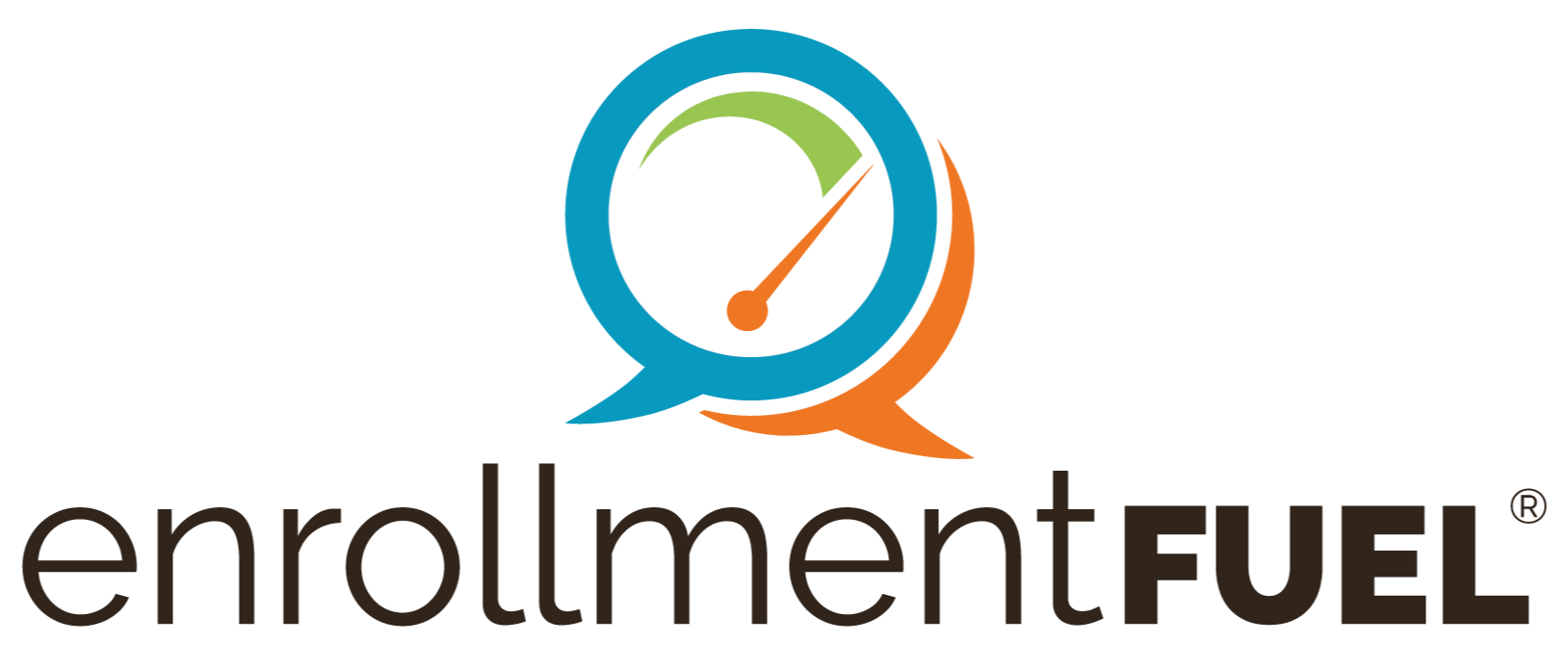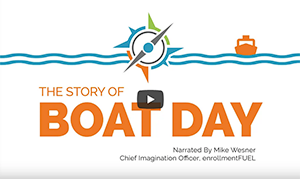7 min read
From Clay to Gold: Leadership Lessons Among Chaos
“It was the best of times, it was the worst of times.” To me, it seems Charles Dickens described 2020 with this famous quote from A Tale of Two Cities. The worst of times is obvious, given the changes COVID has brought upon us, but many would question my reference regarding the best of times.
Necessity is the mother of invention, and often, the best ideas are born from chaos. During the past year, enrollment leaders were tested and forced to re-examine long-held assumptions. As you prepare for spring, I wish to share three leadership ideas to consider. Each idea brings a new way to look at leadership in less than predictable times.
1—REPETITION VS. ROUTINE
For most of us, routine is our friend. It provides that rhythm that keeps us humming. As Thoreau said, “Routine is a ground to stand on, a wall to retreat to.”
The problem with routine as a leader is that it limits us from exploring new methods, new technology, and innovation. We like our routines, so why change them? Interestingly, routine is often confused with expertise. What I posit here is that as leaders, we need to be more focused on repetition instead of routine not only for ourselves, but for our staff.
As I consult around the country, over and over, the staff tells me they have been trained, but there are often large gaps between the time of training and the time of doing.
When a new admission counselor joins your team, they get soup-to-nuts training early on. It covers everything from travel (yes, we used to travel!) to processing applications to working deposits. Knowledge is passed on, but admission counselors don’t have the opportunity to develop muscle memory because all knowledge is not immediately put into practice. The “knowing-doing gap” and Ebbinghaus’s forgetting curve point to the severity of the problem: We quickly forget most of what we learn unless we consistently apply it. When leaders have a “train early, train once” routine, and people don’t immediately do the tasks in a job, they lose anywhere from 40% to 80% of what they encountered in training.
Here is where repetition comes into play. If we really want our teams to do better, we have to give our staff space to repeat processes until they master them. And, even more importantly, we must also repeat what we have said to ensure our team grasps concepts. When leaders and trainers fall into the trap of thinking, “I already told you how to do X,“ or saying, “I already showed you that,” the staff often picks up on the leader’s frustration. The staff folds inward and stops asking for help, jeopardizing the learning process required to do their work—and do
it well.
Takeaway? Routine often creates lethargy and lack of innovation, while repetition allows us to hone a skill to be as good as we can possibly be.
Action? Space out training into smaller increments. Let your staff ask questions and practice using knowledge. Then, move to the next small increment you want them to learn. This spring, restart staff training on desired outcomes, so they can meet that expectation.
2—BETTER VS. BEST
When I was growing up, I remember my fourth-grade teacher, Ms. Randolph, saying:
“Good, better, best,
Never let it rest,
Until your good is better than your best.”
For years, that little expression stuck with me as I tackled tasks, whether it was homework, chores, or practicing for my singing lessons. My best was a place that could always be improved upon with that mindset—a paradox of sorts.
Interestingly, as I took on more leadership positions, that important life lesson slipped away. I always focused on being the best in my department. I wanted my staff to be their best and pushed for that. As I examined the past year, and the many changes it has brought to our work environments, I have paused, gone back to my early roots, and thought about better.
This cycle brings the word “better” into consideration, and in many cases, crumbled practices once considered best. Why? Because when things were stable in an office, and practices were honed, individuals considered them to be the best in that place and time. Then, a new place and time (chaos) hit. Our best processes had to be done away with, replaced by something that was a better fit for a particular moment.
Here is the secret—better is incremental and never finite. If we ask people to do better, it’s manageable. It isn’t overwhelming, it does not create pressure, and it gives people hope because the best is usually the top position or winner, and there is only one.
Better is inclusive of every person on the team. Better is always striving for the next great thing, while best gives a perceived notion of already being at the pinnacle. Best causes people to accept where they are as being perfect, so why keep looking, trying, experimenting, and tinkering? On the other hand, better nudges people, giving them that next incremental push, and never allows us to rest on our laurels.
Takeaway? Asking staff to be the best can negatively impact what we seek in two ways. First, it allows people who think they cannot be the best to give up. And second, it allows staff to perceive when they have reached a certain point, there isn’t anything else to achieve.
Better, on the other hand, is inclusive. Everyone can be better, and it allows people to keep pushing in incremental stages (paradoxically achieving the status of best).
Action? This spring, in your one-on-one meetings with staff, ask them what they think can be better in the office. Nothing is off the table, whether it is a process, task, training, meeting structure, operation, policy, etc. Then, assign each person one thing to “make better” and allow them ownership. When they have completed the task, highlight it, and celebrate it openly. Keep moving down the list of things to accomplish that can “be better,” and before you know it, morale will increase. When people have a sense of purpose (and something known) in these unusual times, it creates a genuine win for your team.
3—KNOWING VS. DOING
About a decade before I was born, a group of monks in Thailand decided to move a ten-and-a-half foot clay statue of Buddha to a new temple. As they were moving it, the clay cracked, revealing something shiny. A monk chipped away at the crack, revealing a Buddha of solid gold. It is speculated that the earlier monks encapsulated the Buddha to hide it from the Burmese soldiers, thus, hiding the true identity of the Buddha until it was uncovered hundreds of years later.
Leaders sometimes become a clay Buddha as they climb the ladder of success. Deep inside is the gold that promoted them to their leadership position, hidden by the clay of the everyday minutia of endless checklists, meetings, fires, and operational distress, hiding their true leadership identity.
In most leadership theories, the research encourages that knowing is not enough, and doing is the key to energized leadership, accomplishment, and leading by example. However, I want to flip this concept in the current environment and say that we need to focus as leaders more on the knowing than the doing during the next few months. Why? Because we have staff who can do and implement for days—they are good at it, giving them a sense of accomplishment. What they are looking for in this environment is a leader who knows answers, knows how to problem-solve, and knows when to use emotional intelligence to calm fears of the unknown. Staffers hunger for the contemplative strategist, even when that means being transparent and letting the staff know when the strategy is not clear and explaining what is known at the moment.
I don’t mean to advocate that leaders should think and pontificate for days without taking action. Rather, I believe activity for the sake of activity, and doing in the absence of knowledge, is not the best answer in this current work environment. A thoughtful and present leader is needed more than ever, and your institution counts on you to bring that value to your team.
Takeaway? While knowing and doing are essential aspects of leadership, the main focus in leadership theory has been on doing and execution. In this current environment, I challenge leaders to pause, spend more time honing their knowledge of what to do, the actions to be taken by others, and the communication of knowledge to create a sense of calm and stability.
Action? Sit quietly this spring every week for an hour, and list three things you know about your current landscape. In staff meetings, announce those three things. Communicate with confidence. Assign tasks if something needs to be addressed to change the situation. Close the loop every week on the last three things. For example: “I realize students are not attending the virtual visits we have set up, and this is causing great stress for all of us. Sally and John, I want the two of you to meet this week and come back next week with a plan for two new ideas we can implement to connect with students in a meaningful way.”
While 2020 threw us all for a loop, there are many lessons we can take from the year to help us examine and flip previous philosophies to better lead our teams in the moment in which we find ourselves. Three such areas include training to reduce the forgetting curve, focusing on being better rather than the best, and being a practitioner of knowledge accumulation and dissemination.
As leaders, we all have inner gold waiting to be found. By implementing the above strategies, you can be a gold Buddha to your staff by helping them better learn and retain for output, push to continually be better, and have a sense of calm in the work they do every day with you at the helm.
- Retrieved from https://www.goodreads.com/quotes/341391-it-was-the-best-of-times-it-was-the-worst
- Retrieved from: https://libquotes.com/henry-david-thoreau/quote/lbu6b8k
- Chun, B.A. & Heo, H.J. The effect of flipped learning on academic performance as an innovative method for overcoming ebbinghaus’ forgetting curve ICIET ‘18: Proceedings of the 6th International Conference on Information and Education TechnologyJanuary 2018 Pages 56-60 https://doi.org/10.1145/3178158.3178206
- Retrieved from: https://theculturetrip.com/asia/thailand/articles/the-amazing-story-of-the-worlds-biggest-solid-gold-buddha-statue/
Download Article
Related Articles
Mini-Case Studies Just Right for 2021
No one can dispute what an unpredictable, ambiguous, and upside-down year 2020 was. You may be...
Boundless Organizations—5 Stages of SEM Office Evolution
During our travels across the wide landscape of U.S. higher education, we have seen many different...
Aligning New Board Members to Your Way of Thinking
Even before the upheavals caused by the global pandemic, college and university boards have...





Leave A Comment